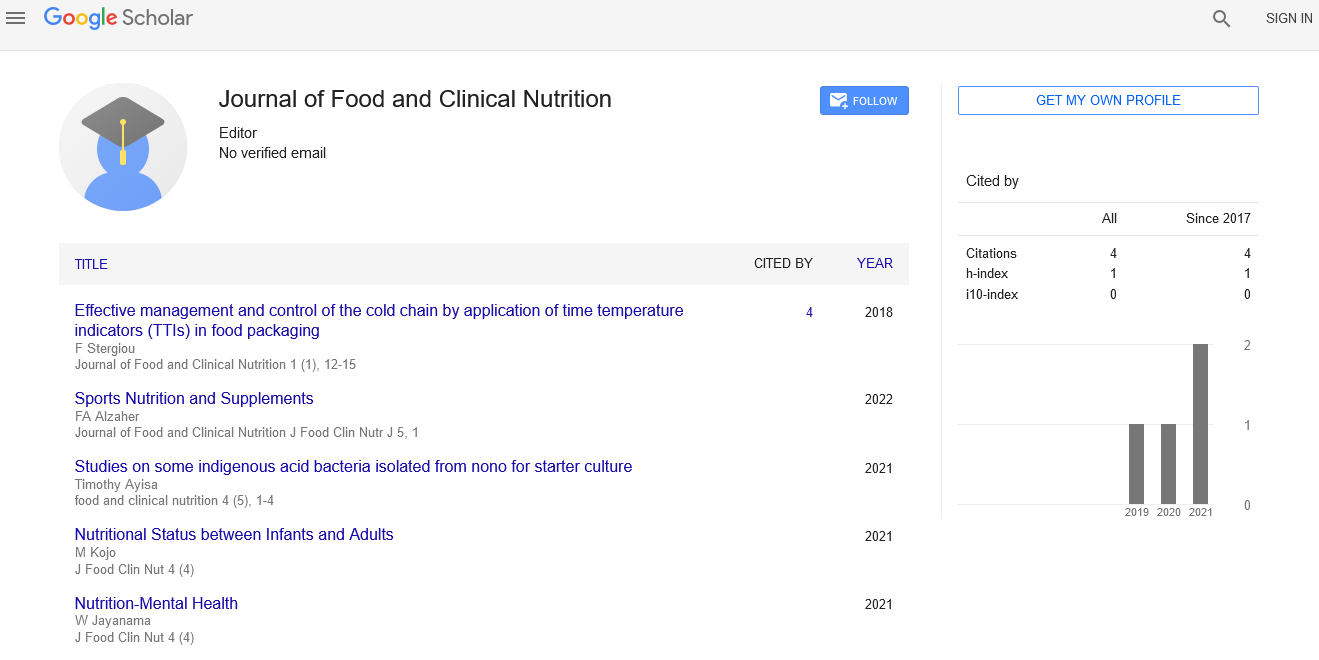Antioxidants for health
Received: 20-Nov-2017 Accepted Date: Nov 22, 2017; Published: 27-Nov-2017
Citation: Lima KO. Antioxidants for health. J Food Clin Nutr 2017;1(1):4.
This open-access article is distributed under the terms of the Creative Commons Attribution Non-Commercial License (CC BY-NC) (http://creativecommons.org/licenses/by-nc/4.0/), which permits reuse, distribution and reproduction of the article, provided that the original work is properly cited and the reuse is restricted to noncommercial purposes. For commercial reuse, contact reprints@pulsus.com
T he release of a scientific journal is always something memorable since it is of fundamental importance for the dissemination of the scientific discoveries and of paramount importance for the advances in the researches. In this context, the Journal of Food and Clinical Nutrition aims to contribute to scientific development through the publication of research in the area. Increasingly, healthy food has gained prominence in recent years, in addition to nutritional aspects, research has been dedicated to discovering the possible positive effects of food on the organism. The natural antioxidants found in several foods have aroused interest because they can provide different health benefits by combating reactive oxygen species. The accumulation of these reactive species can lead to irreversible cell damage, such as by oxidation of essential cellular components such as membrane lipids, proteins, and DNA [1]. These organelles, when damaged, are more likely to produce free radicals creating a vicious cycle leading to increased cell damage and senescence. Following this line, the endogenous antioxidant defense plays a fundamental role in this process, therefore the importance of the study of alternative possibilities and if possible, sustainable and natural, of compounds that aid in intracellular redox balances. Therefore, the use of natural antioxidants is a promising strategy, especially regarding cell oxidation. Antioxidants have been used to promote health and reduce the risk of diseases such as diabetes, cardiovascular disease, atherosclerosis as well as aging among others [2] searching a healthy aging process. Natural antioxidants have none or few side effects compared to synthetic ones, which can present health risks, demonstrating the great importance of the world scenario. In this context, the hydrolyzed proteins have gained prominence, since they can present several bioactivities among them the antioxidant property, this occurs through the release by hydrolysis of the peptides that are inactive within the protein molecule [2-4]. It is noteworthy that hydrolysis conditions are important parameters in this process because affect the antioxidant activity presented since they determine the peptide profile [5]. In general, natural antioxidants are generally unstable molecules that are sensitive to heat and light, which can cause change or loss of bioactivity by limiting their application. In addition, some of these compounds have other limitations such as unpleasant taste and reduced bioavailability [6]. Thus, protecting such compounds from such actions is essential to ensure their properties, encapsulation being a relevant technology to increase their use by isolating the sensitive substance within the capsule [7]. It is a reliable technique capable of improving the retention time of the nutrient in the food, allows controlled and directed release, preserves the stability of the compounds during processing and storage, avoids undesirable interactions with the food matrix, retards the degradation processes, masks the taste and increases bioavailability while maintaining the properties of the compound [8-10]. Given the great importance of these issues and the potential benefits, it is of the utmost importance that research progress as well as case reports be widely available to the community in order to contribute to scientific and technological knowledge and development.
REFERENCES
- Poljsak B, Suput D, Milisav I. Achieving the balance between ROS and antioxidants: When to use the synthetic antioxidants. Oxidative Medicine and Cellular Longevity 2013;e95679.
- Najafian L, Babji AS. A review of fish-derived antioxidant and antimicrobial peptides: Their production, assessment, and applications. Peptides 2012;33:178-185.
- Chi CF, Hu FY, Wang B, et al. Purification and characterization of three antioxidant peptides from protein hydrolyzate of croceine croaker (Pseudosciaena crocea) muscle. Food Chem 2015;168:662-667.
- Sila A, Bougatef A. Antioxidant peptides from marine by-products: Isolation, identification and application in food systems: A review. J Funct Foods 2016;21:10-26.
- Chalamaiah M, Dinesh Kumar B, Hemalatha R, et al. Fish protein hydrolysates: Proximate composition, amino acid composition, antioxidant activities and applications: A review. Food Chem 2012;135:3020-3038.
- Liu M, Wang Y, Liu Y, et al. Bioactive peptides derived from traditional Chinese medicine and traditional Chinese food: A review. Food Res Int 2016;89:63-73.
- Neves MA, Hashemi J, Prentice C. Development of novel bioactives delivery systems by micro/nanotechnology. Curr Opin Food Sci 2015;1:7-12.
- Aguiar J, Estevinho BN, Santos L. Microencapsulation of natural antioxidants for food application–The specific case of coffee antioxidants–A review. Trends Food Sci Technol 2016;58:21-39.
- Agnihotri N, Mishra R, Goda C, et al. Microencapsulation–A novel approach in drug delivery: A Review. J Pharm Sci 2012;2:21-20.
- Poshadri A, Kuna A. Microencapsulation technology: A review. J Res ANGRAU 2010;38:86-102.





